Was the world made safe for democracy by the U.S. actions during the Cold War?
Historians generally date the Cold War from the end of World War II to the collapse of the Soviet Union in 1991. It refers to the intense rivalry for world domination between the United States and its allies on one hand and the Soviet Union and other communist countries on the other. While there were no direct military conflicts between the two superpowers, there were several armed clashes with military support by one side or the other or both. In the early 1950s, the Korean War pitted the South Korea, United States and others under the flag of the United Nations against North Korea and Communist China.
Cold War Arms Race
Cold War tensions grew ever more grave with the invention of atomic weapons by both sides. Both the U.S. and the Soviets invested in massive nuclear build-ups designed to so threaten the devastation of the other that an attack would be unthinkable. Both countries greatly increased military spending. However, nuclear deterrents did not stop ground wars between other nations and intense economic and diplomatic competition. The arms race even extended into space with programs first of satellites and then of manned space flights.
The U.S. adopted the policy of containment first developed by diplomat George Kennan. It did not seek to push back the Soviets from Eastern Europe or Communist Chinese on the theory that their own internal weaknesses would eventually lead to their collapse. It was, however, committed to preventing the spread of communism ("containment") to new territories. In the 1950s, nationalist forces in Vietnam tried to overthrow the French colonial power and drew support from neighboring Communist China. Fearing what was called the "domino effect", the U.S. stepped in when the French were defeated to prevent losing neighboring Southeast Asian nations one by one to communist-aligned forces. Eventually, the North Vietnamese army forced a U.S. withdrawal after staggering losses of soldiers and civilians on both sides.
Americans' Response to the Vietnam War
American involvement in Vietnam was very unpopular at home. President Lyndon Johnson, fearing an expansion of communism in Southeast Asia, committed even more troops to the conflict. With political opposition mounting, Johnson refused to seek election in 1968. President Richard Nixon sought a military victory with more and more American troops, provided by a draft of young American men. Colleges proved to be particularly strong staging grounds for protests against U.S. policy, sometimes leading to illegal or even violent demonstrations. Protesters clashed with police at the 1968 Democratic convention in Chicago, providing an ugly window on a breakdown in the U.S. political process. That led both parties to re-examine their nomination policies to be more inclusive to minorities, women and young voters who felt that they had been frozen out of the top level of decision-making.
American economic superiority eventually led to the collapse of the Soviet Union. President Ronald Reagan instituted a major build up of military forces in the 1980s. The Soviet Union attempted to match American commitments but could not sustain the effort, leading the Russians to severe domestic problems. The Soviets could no longer keep in place the troops necessary to keep satellite countries in submission, and Eastern European countries began to throw off Soviet rule. The Soviet Union itself split into Russia and several independent nations.
The Cold War was over, leaving the United States as the world's only superpower. However, the Russians retained their nuclear arsenal, and the rise of religious and ethnic tensions in the Middle East and China's dramatic rise as a major economic and military power created new challenges to world peace.
Supporting Questions
What ideas influenced US policy during the Cold War?
- "Southeast Asia Treaty Organization (SEATO) Nations," ca. 1950-1975 (Video)
- Operational Priority Communication from Strategic Services Officer Archimedes Patti, September 2, 1945 (Document)
- Letter from Ho Chi Minh to President Harry Truman Asking for Intervention, February 28, 1946 (Document)
- Truman Doctrine, March 12, 1947 (Document)
- "Come South" Propaganda Poster, August 5, 1954 (Image)
- "Communism Means Terrorism," September 15, 1954 (Image)
- "America's Stake in Vietnam" Speech by U.S. Senator John F. Kennedy, June 1, 1956 (Document)
- "No. 52 Vietnam" NSA Memorandum, May 11, 1961 (Document)
How did changes in technology impact global cooperation/alliances during the Cold War?
- "No. 115 Defoliant Operations in Vietnam" NSA Memorandum, November 30, 1961 (Document)
- "Nuclear Test Ban Treaty, July 26, 1963 (Document)
- "Stick 'em up!" June 9, 1964 (Political Cartoon)
- "Iowa Veteran Describes Tactics of the Enemy During the Vietnam War" from Iowa Public Television, 2015 (Video)
- "U.S. Army Veteran’s Perspective on the Mindset of the South Vietnamese Soldiers During the Vietnam War" from Iowa Public Television, September 10, 2017 (Video)
How effective was U.S. diplomacy in creating or eroding safety in the world?
- Letter from Iowa Soldier during the Vietnam War, Date Unknown (Document)
- "Vietnamese Army's Seven Commandments" Propaganda Poster, May 28, 1956 (Image)
- Letter Detailing Agricultural Issues in North Vietnam, 1963 (Document)
- Memorandum of World's Reaction to Developments in Vietnam, September 14, 1963 (Document)
- "Aggression from the North" Propaganda Poster, April 23, 1965 (Image)
- Saigon CIA Chief's Assessment of Vietnam, March 17, 1975 (Document)
- "U.S. Army Veteran Describes the Role of Military Advisors in Vietnam in the 1960s" from Iowa Public Television, September 10, 2017 (Video)
- "The U.S. Exit From Vietnam War: U.S. and South Vietnamese Veterans Share Their Perspectives" from Iowa Public Television, September 10, 2017 (Video)
| Cold War: Vietnam Teaching Guide |
| Printable Image and Document Guide |
"Southeast Asia Treaty Organization (SEATO) Nations," ca. 1950-1975

Description
This video is about the Southeast Asia Treaty Organization (SEATO), and it aired on "The Big Picture" Television Program Series, which was created by the U.S. Army. Only the first two minutes are available in this clip. SEATO was created in September 1954 and ended in…
Operational Priority Communication from Strategic Services Officer Archimedes Patti, September 2, 1945
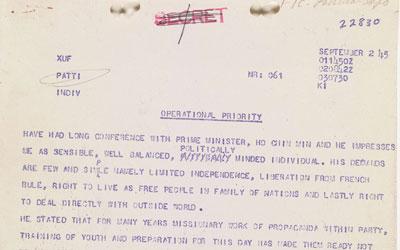
Description
In 1945, during World War II, Japanese troops took control of Vietnam (under French rule at the time). At the end of the war, Ho Chi Minh — the Vietnamese Communist leader—seized an opportunity to escape decades of French rule. The day Japan surrendered to the Allies, Ho…
Letter from Ho Chi Minh to President Harry Truman Asking for Intervention, February 28, 1946
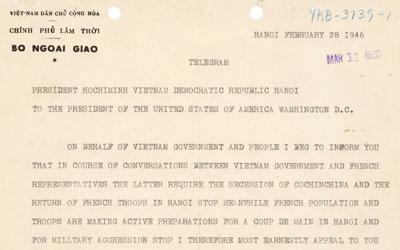
Description
Following the end of World War II, Ho Chi Minh reached out to President Harry S. Truman for support in ending French rule in Vietnam. In the document, Ho Chi Minh references both the Atlantic and San Francisco charters as a basis for his claims. The Atlantic Charter was…
Truman Doctrine, March 12, 1947

Description
President Harry S. Truman presented this address on March 12, 1947, before a joint session of Congress. His message, known as the Truman Doctrine, asked Congress for $400 million in military and economic assistance for Turkey and Greece, to provide U.S.…
"Come South" Propaganda Poster, August 5, 1954
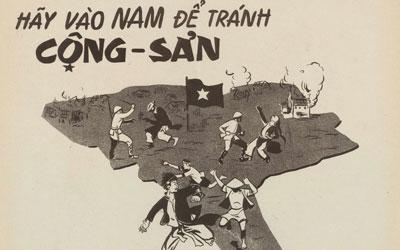
Description
The 1954 Geneva Accords called for a temporary partition of Vietnam at the 17th Parallel — creating a Communist state in the North and a French-backed non-Communist state in the South. There was a 300-day period of free travel between North and South Vietnam before the…
"Communism Means Terrorism," September 15, 1954
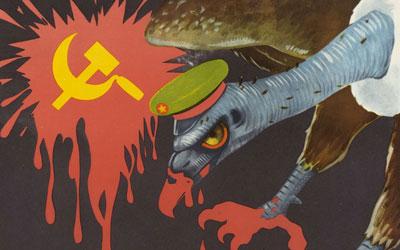
Description
This poster, created and distributed internationally by the United States Information Agency (USIA), was designed to amplify fear of communism in a newly-divided Vietnam. This poster from 1954 reads, "Anywhere there is communism, there is terrorism and assassination!"…
"America's Stake in Vietnam" Speech by U.S. Senator John F. Kennedy, June 1, 1956
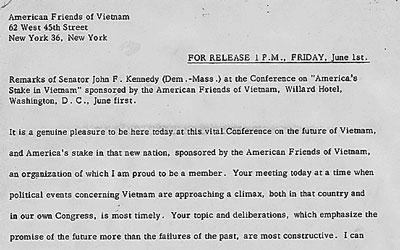
Description
This speech was given by U.S. Senator John F. Kennedy during a time when Vietnam was to hold an election to reconcile the country as laid out in the 1954 Geneva Accords. However, the U.S. was concerned that this would give too much power to the communists at the time.…
"No. 52 Vietnam" NSA Memorandum, May 11, 1961
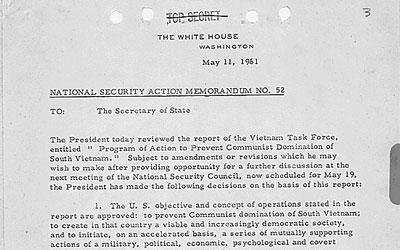
Description
Following research gathering in Vietnam, the document outlines the actions of President John F. Kennedy. In 1961, politically and militarily, President Ngo Dinh Diem's regime was losing supporters. By January of 1962, the U.S. began military action directly against the…
"No. 115 Defoliant Operations in Vietnam" NSA Memorandum, November 30, 1961
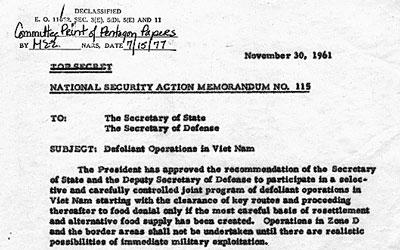
Description
The use by the U.S. military of defoliants such as Agent Orange under the codename Operation Ranch Hand has been controversial since the war ended. During the war, the use by some was viewed as necessary to fight both to expose the enemy and to make it difficult for the…
"Nuclear Test Ban Treaty," July 26, 1963
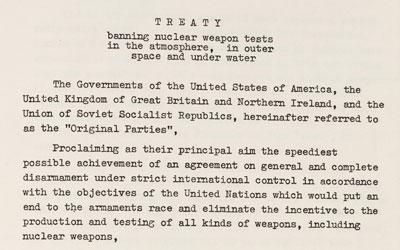
Description
Continued testing of atomic and then hydrogen devices led to a rising concern about the effects of radioactive fallout. As knowledge of the nature and effects of fallout increased, and as it became apparent that no region in the world was untouched by radioactive debris,…
"Stick 'em up!" June 9, 1964
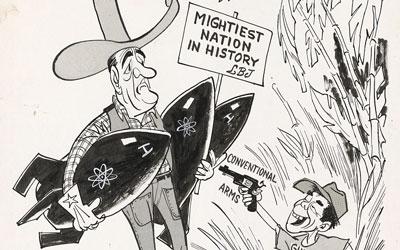
Description
This political cartoon shows the irony of the conflict in Vietnam. At the time the cartoon was created, the United States had the most advanced nuclear arsenal, however, all of the advanced technology did not guarantee the U.S. a victory in Vietnam. Following the events at…
"Iowa Veteran Describes Tactics of the Enemy During the Vietnam War" from Iowa Public Television, 2015
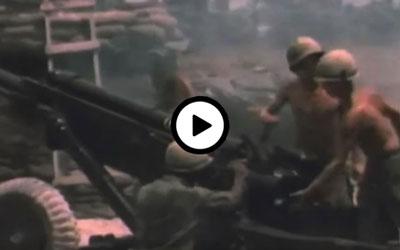
Description
Iowa veteran Vincent Lewis describes an experience with enemy tactics while serving in an artillery unit during the Vietnam War. The Viet Cong forces learned they could intercept U.S. troops' communications on the battlefield and order U.S. planes to drop bombs on their own…
"U.S. Army Veteran’s Perspective on the Mindset of the South Vietnamese Soldiers During the Vietnam War" from Iowa Public Television, September 10, 2017
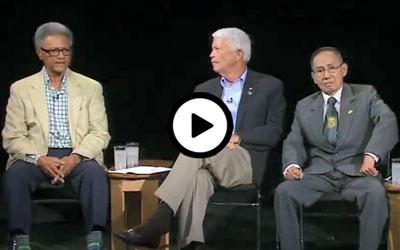
Description
Veteran Caesar Smith gives his perspective on the mindset of South Vietnamese soldiers he served with who had been fighting for their country's freedom since World War II. Smith was a career military officer who served two tours in Vietnam. In 1964, he was a U.S. advisor to…
Letter from Iowa Soldier during the Vietnam War, September 6, 1967

Description
The letter from James (Jim) Leonardo, an employee at the State Historical Museum to one of his co-workers, outlines his experience in Vietnam. The letter was typical of soldiers writing home during this time period. In 1967, Vietnam was drawing to a close and the…
"Vietnamese Army's Seven Commandments" Propaganda Poster, May 28, 1956
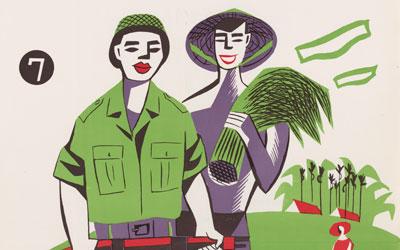
Description
This source comes from a series of propaganda posters showing how the South Vietnamese military supports agricultural production. The image shows a farmer and South Vietnamese soldier together in a field, and promoting how the military was supporting and…
Letter Detailing Agricultural Issues in North Vietnam, 1963
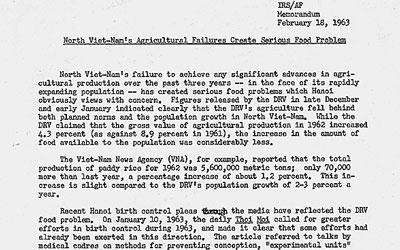
Description
The letter from the United States government details agricultural issues experienced by the North Vietnamese in the early 1960s. Given the central role agriculture plays in communism these failures were something the U.S. hoped to exploit in their propaganda campaigns.…
Memorandum of World's Reaction to Developments in Vietnam, September 14, 1963

Description
The declassified memo comes just a few months before President John F. Kennedy's assassination. During the majority of his presidency, Kennedy threw support, both financially and militarily, to the Ngo Dinh Diem regime. In the memo, the overall disapproval of Diem is clear…
"Aggression from the North" Propaganda Poster, April 23, 1965
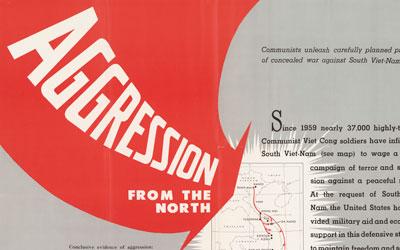
Description
A 1965 policy paper entitled "Aggression from the North" described the justification for America's intervention in Vietnam. It portrayed the war as an invasion by the North Vietnamese with Moscow pulling the strings. Critics insisted it was a civil war instigated by…
Saigon CIA Chief's Assessment of Vietnam, March 17, 1975
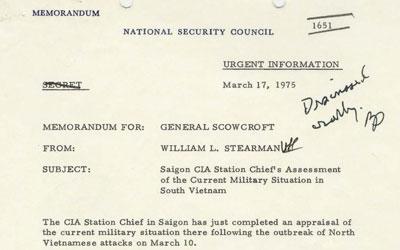
Description
This item is a National Security Council memorandum from National Security Council staffer William L. Stearman to U.S. National Security Advisor Brent Scowcroft, and an accompanying memo from Scowcroft for President Gerald Ford.
"U.S. Army Veteran Describes the Role of Military Advisors in Vietnam in the 1960s" from Iowa Public Television, September 10, 2017
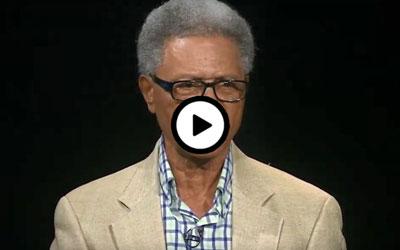
Description
U.S Army veteran Caesar Smith explains the political climate of Vietnam after World War II and the role U.S. advisors played in Vietnam prior to the start of the Vietnam War. Smith was a career military officer who served two tours in Vietnam and retired as a major. In 1964…
"The U.S. Exit From Vietnam War: U.S. and South Vietnamese Veterans Share Their Perspectives" from Iowa Public Television, September 10, 2017

Description
Military veterans from the U.S. and South Vietnamese share their perspective on how the U.S. exited the Vietnam War, and the lasting impact of the conflict. Caesar Smith was a career military officer who served two tours in Vietnam. Dan Gannon is a Marine Corps veteran who…
Additional Resources
- "The Vietnam War" from Iowa PBS
This resource from Iowa PBS has a number of videos and other primary resources about Iowans' experiences in Vietnam. - Battlefield Vietnam: A Brief History
This resource provides an extensive timeline to the events that occurred in Vietnam. The website is hosted by the Public Broadcasting System. - Vietnam War from National Archives
The National Archives have amassed an extensive collection of resources specific to the Vietnam War and has links to a variety of resources from presidential libraries.
Iowa Core Social Studies Standards (9th-12th Grade)
Listed below are the Iowa Core Social Studies content anchor standards that are best reflected in this source set. The content standards applied to this set are high school-age level and encompass the key disciplines that make up social studies for students 9th through 12th grade.
| No. | Standard Description |
| SS-Gov.9-12.22. | Identify and evaluate the contributions of Iowans who have played a role in promoting civic and democratic principles. (21st century skills) |
| SS-Gov.9-12.25. | Evaluate the intended and unintended consequences of the implementation of public policy, specifically looking at the bureaucracy, citizen feedback, public opinion polls, interest groups, media coverage, and other related topics. (21st century skills) |
| SS-Econ.9-12.23. | Explain how globalization has impacted various aspects of economic growth, labor markets, and rights of citizens, the environment, and resource and income distribution in different nations. |
| SS.Geo.9-12.16. | Analyze relationships and interactions within and between human and physical systems to explain reciprocal influences. |
| SS-Geo.9-12.17. | Analyze how environmental and cultural characteristics of various places and regions influence political and economic decisions. |
| SS-Geo.9-12.19. | Analyze the reciprocal relationship between historical events and the spatial diffusion of ideas, technologies, cultural practices and the distribution of human population. |
| SS-Geo.9-12.22. | Evaluate how economic globalization and the expanding use of scarce resources contribute to conflict and cooperation within and among countries. |
| SS-Geo.9-12.23. | Analyze the consequences of human-made and natural catastrophes on global trade, politics, and human migration. |
| SS-US.9-12.20. | Analyze the growth of and challenges to U.S. involvement in the world in the post-World War II era. |
| SS-US.9-12.21. | Analyze change, continuity and context across eras and places of study from civil war to modern America. |
| SS-US.9-12.24. | Critique primary and secondary sources of information with attention to the source of the document, its context, accuracy, and usefulness such as the Reconstruction amendments, Emancipation Proclamation, Treaty of Fort Laramie, Chinese Exclusion Act, Roosevelt’s Corollary to the Monroe Doctrine, Wilson’s Fourteen Points, New Deal Program Acts, Roosevelt’s Declaration of War, Executive Order 9066, Truman Doctrine, Eisenhower’s Farewell Speech, Gulf of Tonkin Resolution, Test Ban Treaty of 1963, Brown vs. Board of Education decision, Letter from a Birmingham Jail, and the Voting Act of 1965. |
| SS-US.9-12.26. | Determine multiple and complex causes and effects of historical events in American history including, but not limited to, the Civil War, World War I and II, the Korean War and the Vietnam War. |
| SS-US.9-12.27. | Evaluate Iowans or groups of Iowans who have influenced U.S. History. |
| SS-WH.9-12.14. | Compare various systems of government, such as monarchies, democracies/republics, empires, and dictatorships, and their methods of maintaining order and/or control. (21st century skills) |
| SS-WH.9-12.16. | Examine the ways in which trade, commerce, and industrialization affected societies. |
| SS-WH.9-12.18. | Assess impact of conflict and diplomacy on international relations. |
| SS-WH.9-12.20. | Evaluate methods used to change or expand systems of power and/or authority. |
| SS-WH.9-12.23. | Critique primary and secondary sources of information with attention to the source of the document, its context, accuracy, and usefulness of sources throughout world history. |
| SS-WH.9-12.24. | Examine and explain how the perspectives of individuals and societies impact world history. |
| SS-WH.9-12.25. | Determine multiple and complex causes and effects of historical events within world history. |
| SS-WH.9-12.26. | Assess Iowans or groups of Iowans who have influenced world history. |